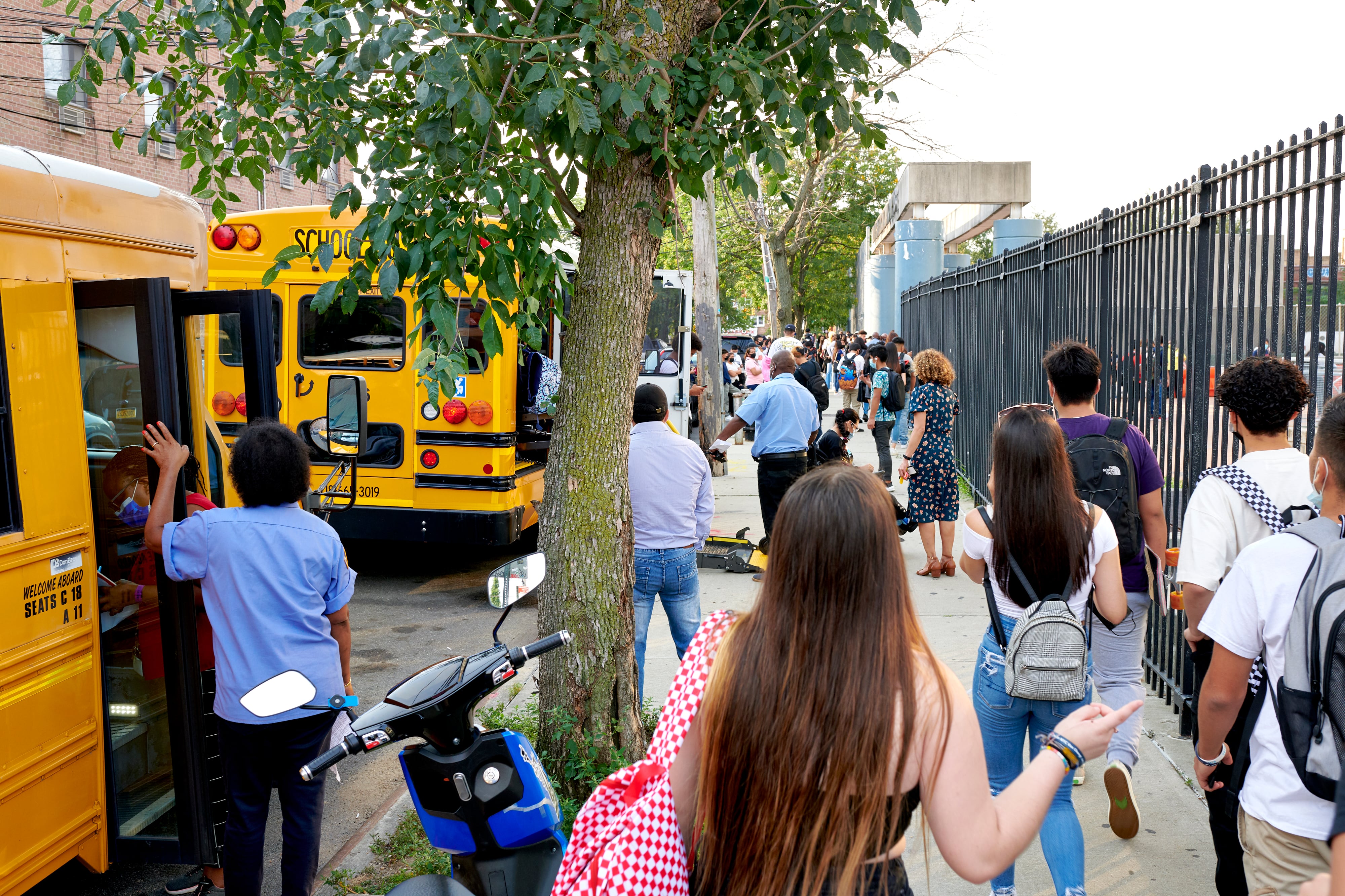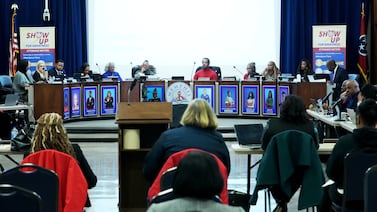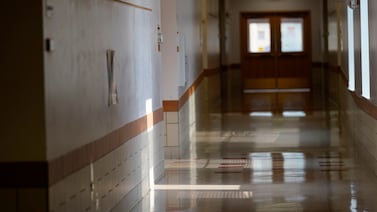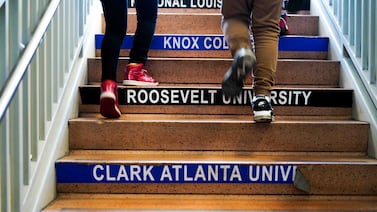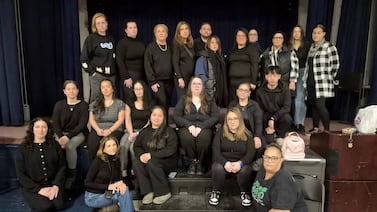Sign up for Chalkbeat New York’s free daily newsletter to keep up with NYC’s public schools.
In New York City’s cutthroat high school application process, a student’s seventh grade GPA in core classes is the single most important factor for whether they get into a highly competitive screened school.
The district puts students into “tiers” based on that GPA. But these tiers also frequently overlap with students’ race, family income, disability status, housing situation, and fluency with English, according to new Education Department data obtained by Chalkbeat. In fact, this system was more than twice as likely to place many groups — Black and Latino students, English learners, and students from low-income families — into its lowest tier, compared with their counterparts, according to a Chalkbeat analysis.
Advocates said the data highlights the role of the city’s selective admissions rules in driving the segregation that has plagued city high schools for years.
“It makes me incredibly angry,” said Nyah Berg, the executive director of Appleseed New York, a group that advocates for school integration and admissions reforms. “We’re limiting opportunities to students because of factors outside of their control … over systemic inequities compounding over years and years.”
Eighth grade applicants are divided into five tiers based on their seventh grade grades in core classes. This year, Tier 1 covers kids who landed in the top 15% citywide, with at least a 94.25% average, or in the top 15% of their school, with at least a 90% average. Tier 5, on the end of the spectrum, comprises the bottom 30% of GPAs, with students who averaged below 76%.
Generally, to have a shot at getting into a highly selective school, students must land in Tier 1. Options for students in the lower tiers grow more constrained, with Tier 5 students losing out to everyone else.
At the top, in Tier 1, only 33% of students were Black and Latino last year, according to the city data, which was first obtained by Bronx parent Tim Smith through a public records request. At the bottom, in Tier 5, 80% of students were Black and Latino. Overall, the eighth-grade applicant pool was 64% Black and Latino.
That pattern persisted across demographic categories, with English language learners, homeless students, kids from low-income families, and students with disabilities generally appearing in higher numbers in the lower tiers.
The disparities were most stark for English learners, who made up just 1% of Tier 1, despite comprising 13% of last year’s eighth grade applicants. English learners made up 27% of Tier 5.
Homeless students and kids with disabilities are also underrepresented in Tier 1 and overrepresented in the lowest tiers.
Specialized high schools, including Stuyvesant and Bronx Science, use a separate admissions exam that is enshrined in state law. But the city’s Education Department controls admission rules for the dozens of screened schools like Townsend Harris, Eleanor Roosevelt, and Millennium, which receive many more applicants than they have seats.
Many selective schools have opted to set aside a portion of seats for students from underrepresented groups. That’s almost certainly boosted the enrollment of those students. But it isn’t enough to fully counteract the segregation baked into the tier system, advocates said.
Some screened schools also give preference to applicants who live in their borough or neighborhood. And roughly two dozen screened schools have permission from the city to use their own admissions criteria, which can include a mix of grades, interviews, and essays.
High school admissions changes again and again
Prior to the pandemic, screened schools had wide discretion to use their own combination of grades, test scores, and other factors, including attendance, to determine admissions. But after the COVID pandemic shuttered schools and upended grades and testing, former Mayor Bill de Blasio centralized the admissions process for screened schools.
He introduced the tier system based on grades, but initially opened Tier 1 to any student with an 85% or higher.
That change put a far greater number of students on equal footing in applying to competitive schools. It helped push the percentage of Black and Latino teens accepted at the city’s 27 most selective screened schools from 28% in 2020 to 40% in 2022.
But when former schools Chancellor David Banks took office in 2022, he opted to tighten access to the top tier, arguing that students with the very highest marks “should not be thrown in a lottery with just everybody.” (Banks did, however, continue the pandemic policy of not including state test scores in high school admissions.)
Following Banks’ changes, 35% of offers to the most selective high schools went to Black and Latino students — down from 2022 but higher than in 2020, according to city data.
Rather than overhauling selective admissions, Banks focused on opening more selective schools in communities with higher concentrations of students who are Black, Latino, and from low-income backgrounds. That effort led to two new Bard Early College High Schools in the Bronx and Brooklyn, and another early college school set to open next year in southeast Queens.
Education Department spokesperson Jenna Lyle said Chancellor Melissa Aviles-Ramos will continue that approach, along with a push to reform literacy and math instruction to increase the share of historically underrepresented students who qualify for the top tiers.
“Tackling these inequities and under-representations has been a top priority for this administration and will continue to be a priority,” Lyle said in a statement.
Meanwhile, an increasing number of screened high schools have opted to participate in the “diversity in admissions” program, where they can set aside a portion of seats for students from underrepresented groups, including those from low-income families, English learners, and homeless students. If there aren’t enough applicants from Tier 1 who are members of those priority groups, schools grant offers to applicants who are members of those groups from Tier 2.
All screened high schools also set aside a portion of their seats for students with disabilities, a process that works similarly to the diversity in admissions program. Some screened schools have significantly boosted their numbers of students with disabilities, including Queens’ Townsend Harris, which roughly doubled its share of such students from 7% in 2019 to 15% last year.
Berg, the integration advocate, said the growth of the diversity admissions programs has been a positive development but isn’t enough to outweigh the tier system.
Using the analogy of a balance scale, Berg said, “One of those scales is essentially bolted to the ground, and we’re putting two-pound weights on the other side.”
Michael Elsen-Rooney is a reporter for Chalkbeat New York, covering NYC public schools. Contact Michael at melsen-rooney@chalkbeat.org .
Kae Petrin is data and graphics reporter for Chalkbeat. Contact Kae at kpetrin@chalkbeat.org

